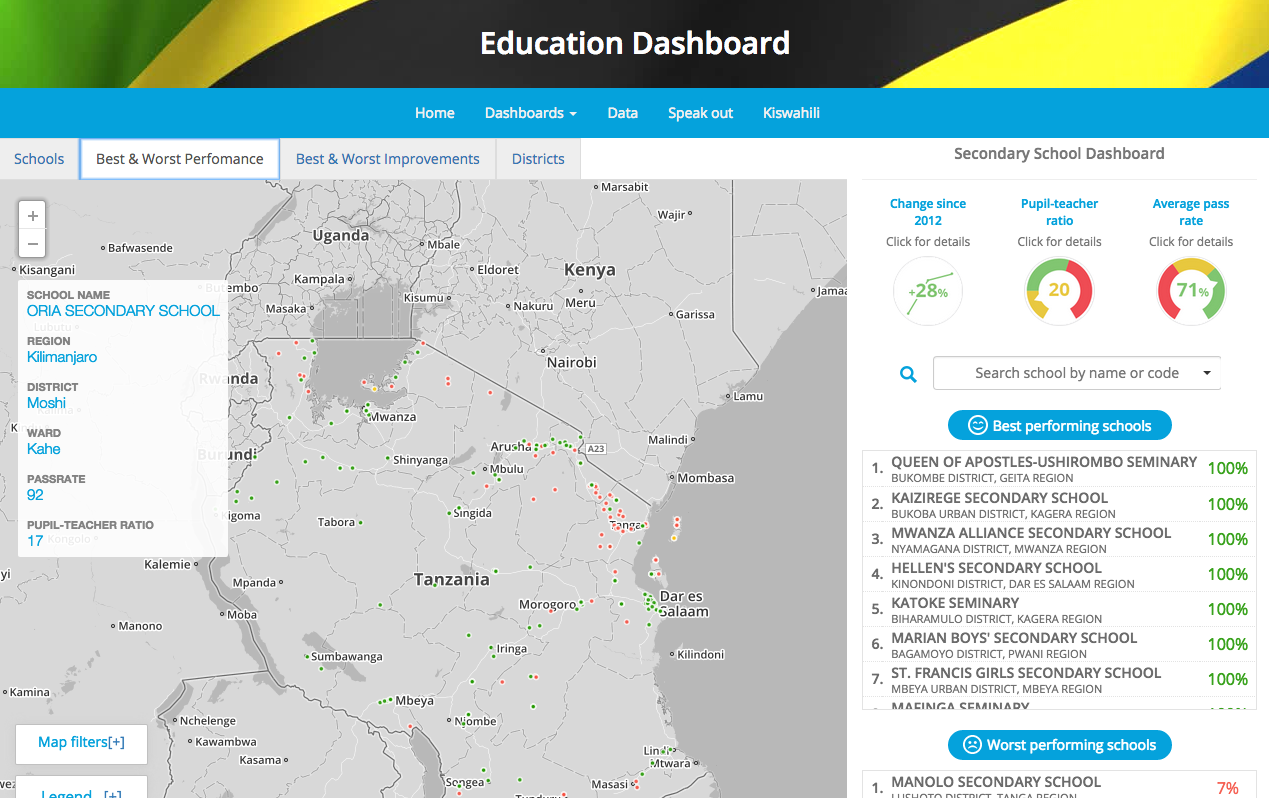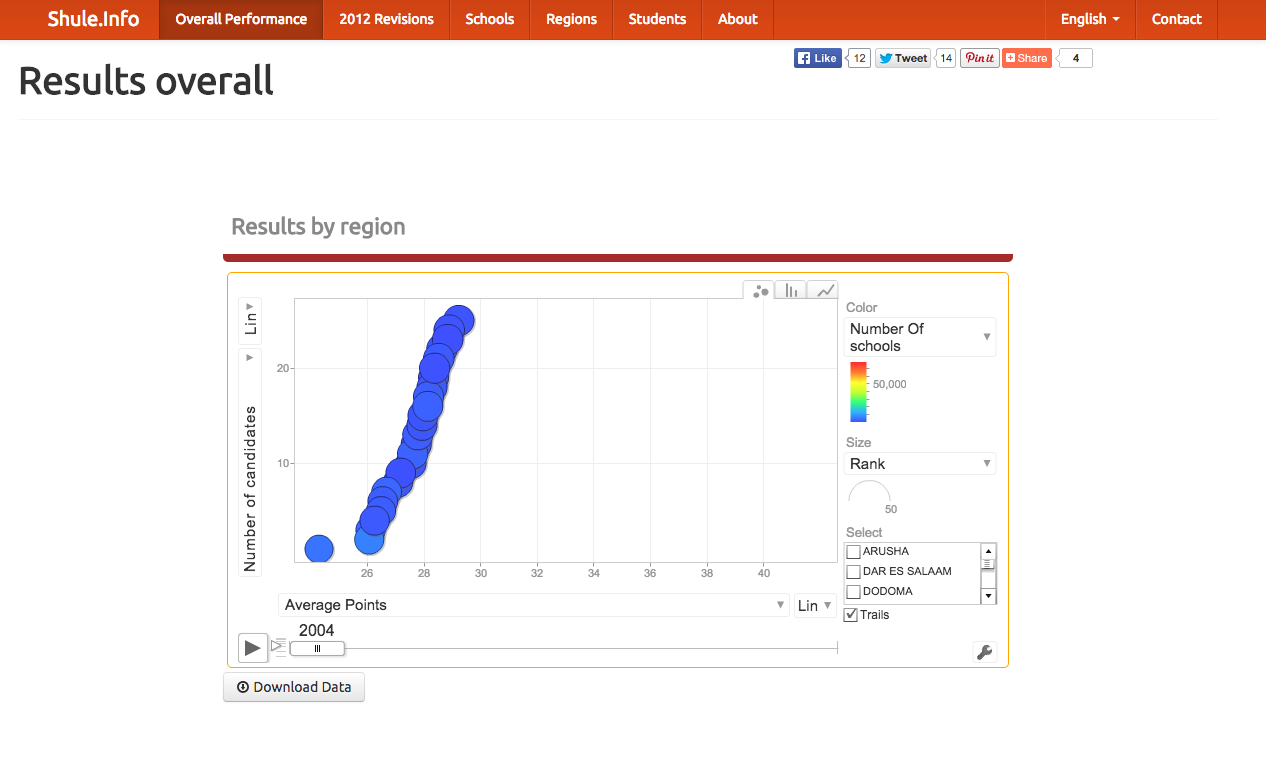The Global Impact of Open Data
Open Education Information In Tanzania
A Tale of Two Dashboards
by Juliet McMurren, Stefaan Verhulst, Andrew Young and David Sangokoya*
Reference
1Kimboy, Frank. “High pass rate greeted as good as well as bad news.” The Citizen. July 23, 2014
http://www.thecitizen.co.tz/magazine/political-reforms/High-pass-rate-greeted-as-good/-/1843776/2394162/-/umh9xl/-/index.html
2“World Data on Education (Revised Version).” UNESCO. August 2010.
http://www.ibe.unesco.org/fileadmin/user_upload/Publications/WDE/2010/pdf-versions/United_Republic_of_Tanzania.pdf
3“Tanzania: World Bank Development Indicators.” Accessed August 28, 2015
http://databank.worldbank.org/data/reports.aspx?source=2&country=TZA&series=&period=
4Magolanga, Elisha. “No more Div. Zero as govt guts national grading system.” The Citizen. November 1, 2013.
http://www.thecitizen.co.tz/News/Govt-in-major-change-of-national-exam-grading/-/1840392/2055404/-/3kae76z/-/index.html
5Kimboy, Frank. “High pass rate greeted as good as well as bad news.” The Citizen. July 23, 2014.
http://www.thecitizen.co.tz/magazine/political-reforms/High-pass-rate-greeted-as-good/-/1843776/2394162/-/umh9xl/-/index.html
6The Citizen Reporter. “Teachers shortage hurting Tanzania.” The Citizen. October 14, 2014
http://www.thecitizen.co.tz/News/Teachers-shortage-hurting-Tanzania/-/1840340/2485582/-/tpeqyi/-/index.html
7Qorro, Edward. “Education Policy: What lies ahead for teachers.” The Citizen. February 24, 2015.
http://www.thecitizen.co.tz/magazine/success/-/1843788/2633842/-/item/3/-/7gk0yk/-/index.html
10In 2010, the African Media Barometer did report, however, that the state-run Radio Tanzania has demonstrated more balanced views within recent years
11Tanzania Country Report – Freedom of the Press 2011. Freedom House. Accessed August 28, 2015. https://freedomhouse.org/report/freedom-press/2011/tanzania#.VaARQ_lVikp
16 Available at http://www.necta.go.tz/opendata/, and subsequently updated at http://www.necta.go.tz/opendata/brn/
17 http://the Education Open Data Dashboard.org/#/
20 GovLab Interview with Arnold Minde, Founder, Shule, July 9, 2015.
21 GovLab Interview with Arnold Minde, Founder, Shule, July 9, 2015.
22 ICT Statistics. ITU. Accessed August 28, 2015. http://www.itu.int/en/ITU-D/Statistics/Pages/stat/default.aspx
23 GovLab Interview with Arnold Minde, Founder, Shule. July 9, 2015.
24 GovLab Interview with Arnold Minde, Founder, Shule. July 9, 2015.
25 GovLab Interview with Arnold Minde, Founder, Shule. July 9, 2015.
26 GovLab Interview with Aidan Eyakuze, Executive Director, Twaweza. July 14, 2015.
27 Bauer, Michael. “The Data Bootcamp in Tanzania.” Open Knowledge Blog. October 25, 2012.
http://blog.okfn.org/2012/10/25/the-data-bootcamp-in-tanzania/
28 Interview with Samhir Vasdev, ICT Sector Unit, World Bank Group and Verena Luise Knippel, Senior Governance Specialist, World Bank June 30, 2015.
29 Interview with Samhir Vasdev, ICT Sector Unit, World Bank Group and Verena Luise Knippel, Senior Governance Specialist, World Bank June 30, 2015.
30 Interview with Samhir Vasdev, ICT Sector Unit, World Bank Group and Verena Luise Knippel, Senior Governance Specialist, World Bank June 30, 2015.
31 “Social Justice.” Open Data for Tanzania. Accessed August 28, 2015. http://tanzania.opendataforafrica.org/igcpumb/social-justice
32 Interview with Samhir Vasdev, ICT Sector Unit, World Bank Group and Verena Luise Knippel, Senior Governance Specialist, World Bank June 30, 2015.
33 “Tanzania: Old Media, New Media.” AfricaFocus. April 5, 2011. http://www.africafocus.org/docs11/tan1104.php
34 ICT Statistics. ITU. Accessed August 28, 2015. http://www.itu.int/en/ITU-D/Statistics/Pages/stat/default.aspx
35 GovLab Interview with Aidan Eyakuze, Executive Director, Twaweza. July 14, 2015.
36 GovLab Interview with Arnold Minde, Founder, Shule. July 9, 2015.
37 Interview with Samhir Vasdev, ICT Sector Unit, World Bank Group and Verena Luise Knippel, Senior Governance Specialist, World Bank June 30, 2015.
38 Interview with Samhir Vasdev, ICT Sector Unit, World Bank Group and Verena Luise Knippel, Senior Governance Specialist, World Bank June 30, 2015.
39 GovLab Interview with Arnold Minde, Founder, Shule. July 9, 2015.
41 GovLab Interview with Arnold Minde, Founder, Shule. July 9, 2015.
42 It is worth noting, however, that even among such groups, awareness of the potential of open data remains at best nascent. Like the public at large, civil society groups also need to be trained to analyze and visualize data.
43 Bauer, Michael. “The Data Bootcamp in Tanzania.” Open Knowledge Blog. October 25, 2012. http://blog.okfn.org/2012/10/25/the-data-bootcamp-in-tanzania/
44 Interview with Samhir Vasdev, ICT Sector Unit, World Bank Group and Verena Luise Knippel, Senior Governance Specialist, World Bank June 30, 2015.




